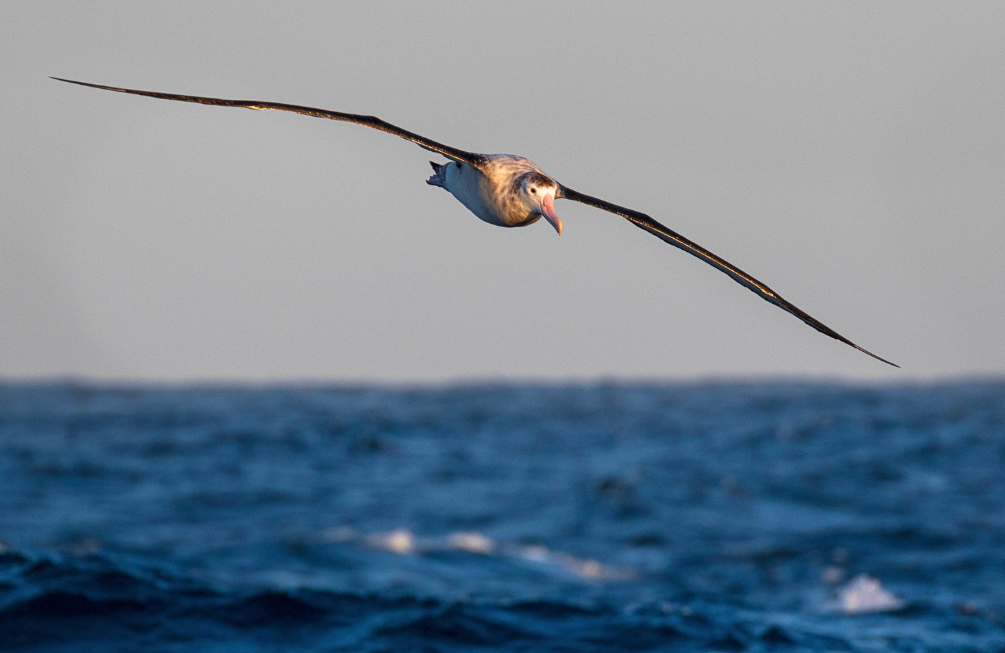
Seabird Capital of the World
New Zealand is one of the world's hotspots for seabird biodiversity. Home to a huge diversity of marine life, each species plays a unique role in the balance of the ocean ecosystem - seabirds included. One-third of nearly 90 species of seabirds that breed in New Zealand are endemic, which means they also call New Zealand home.
Our one-of-a-kind Seaweek t-shirt highlights our amazing marine species, five of which are endemic seabird species. These seabirds breed on our mainland and offshore islands, but nowhere else in the world. Learn more about the featured seabird species on our tee and poster design below.
Antipodean albatross – toroa
NZ Conservation status: Threatened – Nationally Critical
One of the largest albatross species with a wingspan of about three metres - these remarkable birds can remain at sea for very long periods of time. Thirteen albatross species breed in the New Zealand region - more than anywhere else in the world! The Antipodean albatross breed primarily on the Antipodes Island and travel to anywhere from the Chatham Rise to the east of New Zealand, the continental shelf edge near West Australia, or even the west coast of South America to forage.
Listen: Summer 34 – Three decades of albatross research, part of the Voice of Tangaroa series
Watch: Short video by NZ Geographic featuring Live Ocean
Read: Dive int the details and explore research via this DOC webpage
-1715634251-COPY.png)
Fiordland crested penguin - tawaki
Conservation status: At Risk - Declining
The Fiordland Crested penguin is one of the rarest penguins in the world! They are great divers and good penguin parents, the only erect penguin species that can raise two chicks at a time under the right conditions. A 'penguin interview' and downloadable learning resources designed to help young people learn more about these unique birds are available via on our creature content page.
Listen: A tale of two islands – erect-crested penguins, part of the Voice of Tangaroa series
Read: Dive into the details and explore research via this DOC webpage
Explore: The Tawaki Project, a long-term study
Storm petrel – takahikare - raro
Conservation status: Threatened – Nationally Critical
Very little is known about the New Zealand storm petrel, one of our smallest seabirds. Believed to be extinct for about 150 years until being re-sighted in 2003 - researchers then found them to be breeding on Te Hauturu-o-Toi (Little Barrier Island) in 2013 and research to better understand the population size is ongoing.
Read: A story about this special bird by seabird scientist Chris Gaskin
Explore: Find out more on the DOC webpage
Hutton’s Shearwater - kaikōura tītī
Conservation status: Threatened – Nationally Critical
The Hutton’s Shearwater are the only seabird that breeds in a sub-alpine habitat - making them the highest breeding seabirds in the world. Hutton’s shearwaters return from the ocean around late August and make their nests in deep burrows on the Kaikōura Ranges, over 1,200m above sea level. During the winter, the non-breeding season, these shearwaters are known to migrate to Australia where they can be found feeding in warm fish-rich coastal waters, never making landfall.
Read: Learn more about them & how you can help via the Hutton's Shearwater Charitable Trust website
Watch: This 'Meet the Locals' video: Visit a nesting Hutton's shearwater colony (4 minutes)
Chatham petrel - ranguru
Conservation status: Threatened – Nationally Vulnerable
With only around 2,000 individuals remaining, the Chatham’s Island petrel is one of the most endangered seabirds in the world. Suffering due to the introduction of mammalian predators and the loss of forest habitat on Chatham and Pitt islands, at one time in the 1980s there were only 30 breeding pairs known. Incredibly, Chatham petrel can forage up to 3,000 km from the colony.
Explore: Find out more on the DOC webpage
Watch: This 'Meet the Locals' video about the Chatham petrel to learn more
Our Seas are Our Survival
This message integrated into our limited edition tees reinforces the integral role of the ocean in all our lives. Each featured creature has a special story; some have incredible conservation success, but most are in decline.
-1715634452-COPY.png)